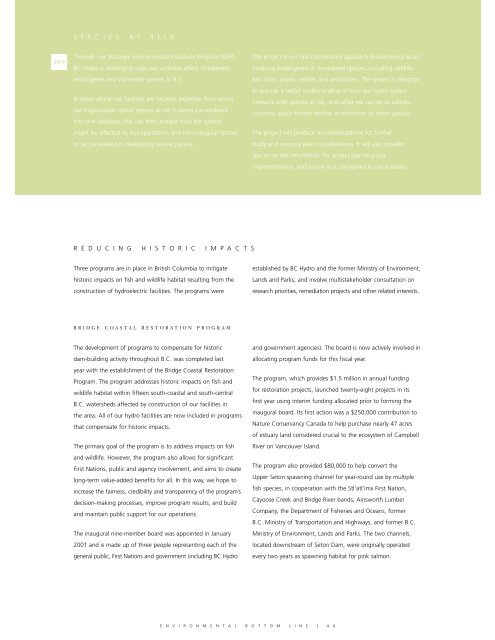2001 Triple Bottom Line Report - BC Hydro
2001 Triple Bottom Line Report - BC Hydro
2001 Triple Bottom Line Report - BC Hydro
Create successful ePaper yourself
Turn your PDF publications into a flip-book with our unique Google optimized e-Paper software.
SEIP<br />
S P E C I E S A T R I S K<br />
Through our Strategic Environmental Initiatives Program (SEIP),<br />
<strong>BC</strong> <strong>Hydro</strong> is identifying ways our activities affect threatened,<br />
endangered and vulnerable species in B.C.<br />
In areas where our facilities are located, expertise from across<br />
our organization about species at risk is being consolidated<br />
into one database. We can then analyze how the species<br />
might be affected by our operations, and the biological factors<br />
to be considered in developing recovery plans.<br />
R E D U C I N G H I S T O R I C I M P A C T S<br />
Three programs are in place in British Columbia to mitigate<br />
historic impacts on fish and wildlife habitat resulting from the<br />
construction of hydroelectric facilities. The programs were<br />
BRIDGE COASTAL RESTORATION PROGRAM<br />
The development of programs to compensate for historic<br />
dam-building activity throughout B.C. was completed last<br />
year with the establishment of the Bridge Coastal Restoration<br />
Program. The program addresses historic impacts on fish and<br />
wildlife habitat within fifteen south-coastal and south-central<br />
B.C. watersheds affected by construction of our facilities in<br />
the area. All of our hydro facilities are now included in programs<br />
that compensate for historic impacts.<br />
The primary goal of the program is to address impacts on fish<br />
and wildlife. However, the program also allows for significant<br />
First Nations, public and agency involvement, and aims to create<br />
long-term value-added benefits for all. In this way, we hope to<br />
increase the fairness, credibility and transparency of the program’s<br />
decision-making processes, improve program results, and build<br />
and maintain public support for our operations.<br />
The inaugural nine-member board was appointed in January<br />
<strong>2001</strong> and is made up of three people representing each of the<br />
general public, First Nations and government (including <strong>BC</strong> <strong>Hydro</strong><br />
The project is our first coordinated approach to examining issues<br />
involving endangered or threatened species, including wildlife,<br />
fish, birds, plants, reptiles and amphibians. The project is designed<br />
to provide a better understanding of how our hydro system<br />
interacts with species at risk, and what we can do to address<br />
concerns about further decline or extinction of these species.<br />
The project will produce recommendations for further<br />
study and recovery plan considerations. It will also provide<br />
species-at-risk information for project planning and<br />
implementation, and ensure it is considered in our activities.<br />
established by <strong>BC</strong> <strong>Hydro</strong> and the former Ministry of Environment,<br />
Lands and Parks, and involve multistakeholder consultation on<br />
research priorities, remediation projects and other related interests.<br />
and government agencies). The board is now actively involved in<br />
allocating program funds for this fiscal year.<br />
The program, which provides $1.5 million in annual funding<br />
for restoration projects, launched twenty-eight projects in its<br />
first year using interim funding allocated prior to forming the<br />
inaugural board. Its first action was a $250,000 contribution to<br />
Nature Conservancy Canada to help purchase nearly 47 acres<br />
of estuary land considered crucial to the ecosystem of Campbell<br />
River on Vancouver Island.<br />
The program also provided $80,000 to help convert the<br />
Upper Seton spawning channel for year-round use by multiple<br />
fish species, in cooperation with the Stl’atl’imx First Nation,<br />
Cayoose Creek and Bridge River bands, Ainsworth Lumber<br />
Company, the Department of Fisheries and Oceans, former<br />
B.C. Ministry of Transportation and Highways, and former B.C.<br />
Ministry of Environment, Lands and Parks. The two channels,<br />
located downstream of Seton Dam, were originally operated<br />
every two years as spawning habitat for pink salmon.<br />
E N V I R O N M E N T A L B O T T O M L I N E | 4 4
















